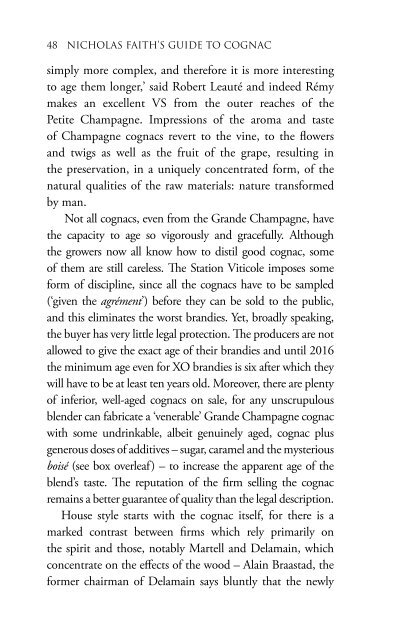Create successful ePaper yourself
Turn your PDF publications into a flip-book with our unique Google optimized e-Paper software.
simply more complex, and therefore it is more interesting<br />
to age them longer,’ said Robert Leauté and indeed Rémy<br />
makes an excellent VS from the outer reaches of the<br />
Petite Champagne. Impressions of the aroma and taste<br />
of Champagne cognacs revert to the vine, to the flowers<br />
and twigs as well as the fruit of the grape, resulting in<br />
the preservation, in a uniquely concentrated form, of the<br />
natural qualities of the raw materials: nature transformed<br />
by man.<br />
Not all cognacs, even from the Grande Champagne, have<br />
the capacity to age so vigorously and gracefully. Although<br />
the growers now all know how to distil good cognac, some<br />
of them are still careless. The Station Viticole imposes some<br />
form of discipline, since all the cognacs have to be sampled<br />
(‘given the agrément’) before they can be sold to the public,<br />
and this eliminates the worst brandies. Yet, broadly speaking,<br />
the buyer has very little legal protection. The producers are not<br />
allowed to give the exact age of their brandies and until 2016<br />
the minimum age even for XO brandies is six after which they<br />
will have to be at least ten years old. Moreover, there are plenty<br />
of inferior, well-aged cognacs on sale, for any unscrupulous<br />
blender can fabricate a ‘venerable’ Grande Champagne cognac<br />
with some undrinkable, albeit genuinely aged, cognac plus<br />
generous doses of additives – sugar, caramel and the mysterious<br />
boisé (see box overleaf) – to increase the apparent age of the<br />
blend’s taste. The reputation of the firm selling the cognac<br />
remains a better guarantee of quality than the legal description.<br />
House style starts with the cognac itself, for there is a<br />
marked contrast between firms which rely primarily on<br />
the spirit and those, notably Martell and Delamain, which<br />
concentrate on the effects of the wood – Alain Braastad, the<br />
former chairman of Delamain says bluntly that the newly<br />
distilled cognac accounts for a mere 25 per cent of the quality<br />
of the final product. By contrast Laurent Robin of Louis<br />
Royer, ‘not wanting to rely on the wood and the progress of<br />
ageing for the quality of the result,’ is ‘looking for the richest<br />
possible raw material’. However, this need not be related<br />
to the wine. When he was at Frapin, Olivier Paultes found<br />
that richer more aromatic wines did not necessarily produce<br />
richer and more complex brandies than more neutral ones.<br />
BOISÉ: COGNAC’S SECRET<br />
INGREDIENT<br />
No one talks much, if at all, about boisé yet it is employed<br />
by many, if not most, producers. It is made by boiling<br />
chips of oak for as long and as often as is required to<br />
produce a thick, brown liquid which can add woodiness<br />
to the brandy and increase its apparent age. It thus<br />
provides a shortcut for those wanting to add a touch<br />
of new wood to their cognacs – and an alternative to<br />
buying new casks which now cost up to £500 each,<br />
which equates to over a pound per bottle of cognac.<br />
Factors in their search for their own style inevitably<br />
include not only the source of the brandy but also the<br />
type of oak and the age of the casks. A high proportion of<br />
Rémy Martin’s cognacs are destined for VSOP brandies, to<br />
be sold within six, or at the most ten, years of distillation,<br />
so it is looking for a type of wood which will speed the<br />
maturation process and, naturally, uses Limousin oak.<br />
Martell uses Troncais because it is looking for precisely the<br />
opposite qualities: the wood has less tannin and is denser<br />
and therefore less porous, so ageing is slower and less wood


